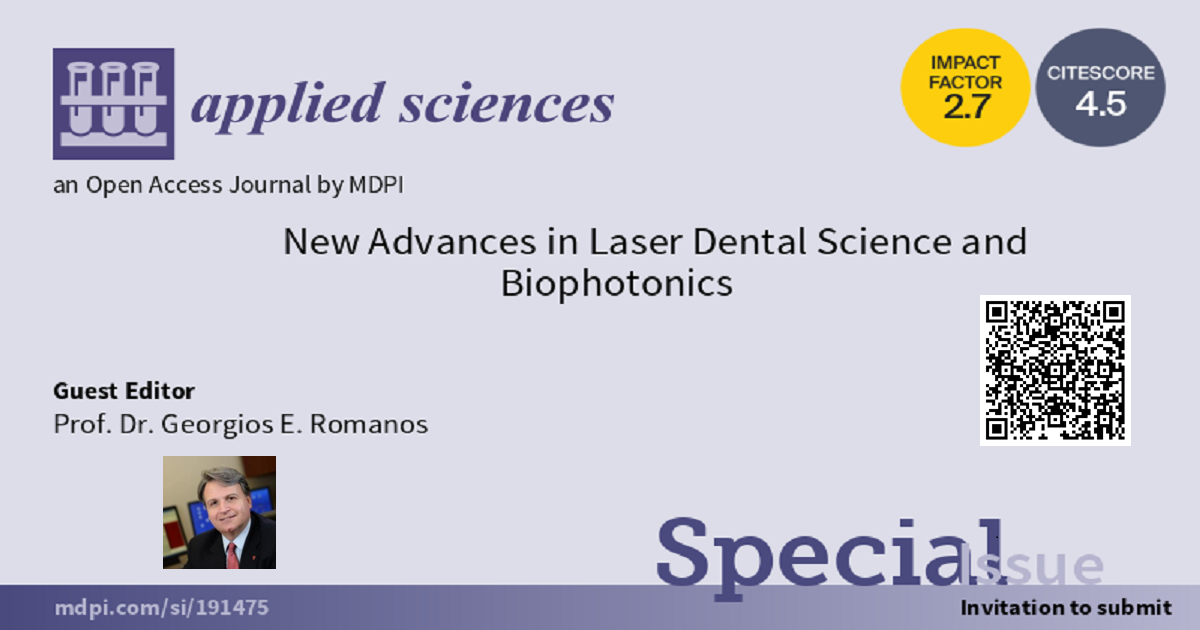New Advances in Laser Dental Science and Biophotonics
A special issue of Applied Sciences (ISSN 2076-3417). This special issue belongs to the section "Optics and Lasers".
Deadline for manuscript submissions: 31 July 2024 | Viewed by 794

Special Issue Editor
Interests: peri-implantitis; lasers; advances in material research; bone regeneration; materials; periodontal regeneration
Special Issues, Collections and Topics in MDPI journals
Special Issue Information
Dear Colleagues,
This Special Issue "New Advances in Laser Dental Science and Biophotonics" provides a forum for the publication of papers on the technical, experimental, and clinical aspects of the use of dental lasers, including lasers in operative dentistry, cariology, periodontology, endodontics, implantology, prosthodontics, orthodontics, aesthetic dentistry, and oral surgery. In addition, this Special Issue will publish papers on the dental application of new lasers, basic laser–tissue interactions, laser safety, photobiomodulation, photodynamic therapy, low-level laser therapy, photodiagnostics, temporomandibular joint and muscle disorders, and TMJ pain management.
Additionally, the latest breakthroughs and innovations in various cutting-edge biophotonic imaging techniques and their applications in biomedicine are welcomed. This collection of research articles brings together the most current developments in optical coherence tomography (OCT), optical coherence microscopy (OCM), photoacoustic tomography (PAT), photoacoustic microscopy (PAM), and fluorescence microscopy (FM). Additionally, the integration of machine learning into biomedicine will be explored to demonstrate its potential in advancing the capabilities of biophotonics.
We extend our sincere gratitude to all the contributing authors for their exceptional contributions to this Special Issue, and we hope this collection will serve as a valuable resource for researchers and practitioners in the field of laser dental science and biophotonics.
Thank you all for your support and dedication to advancing the frontiers of knowledge in this fascinating domain.
Prof. Dr. Georgios E. Romanos
Guest Editor
Manuscript Submission Information
Manuscripts should be submitted online at www.mdpi.com by registering and logging in to this website. Once you are registered, click here to go to the submission form. Manuscripts can be submitted until the deadline. All submissions that pass pre-check are peer-reviewed. Accepted papers will be published continuously in the journal (as soon as accepted) and will be listed together on the special issue website. Research articles, review articles as well as short communications are invited. For planned papers, a title and short abstract (about 100 words) can be sent to the Editorial Office for announcement on this website.
Submitted manuscripts should not have been published previously, nor be under consideration for publication elsewhere (except conference proceedings papers). All manuscripts are thoroughly refereed through a single-blind peer-review process. A guide for authors and other relevant information for submission of manuscripts is available on the Instructions for Authors page. Applied Sciences is an international peer-reviewed open access semimonthly journal published by MDPI.
Please visit the Instructions for Authors page before submitting a manuscript. The Article Processing Charge (APC) for publication in this open access journal is 2400 CHF (Swiss Francs). Submitted papers should be well formatted and use good English. Authors may use MDPI's English editing service prior to publication or during author revisions.
Keywords
- optical coherence microscopy
- biomedical imaging
- biophotonics
- photobiomodulation
- dentistry
- laser–tissue interactions
- laser safety





